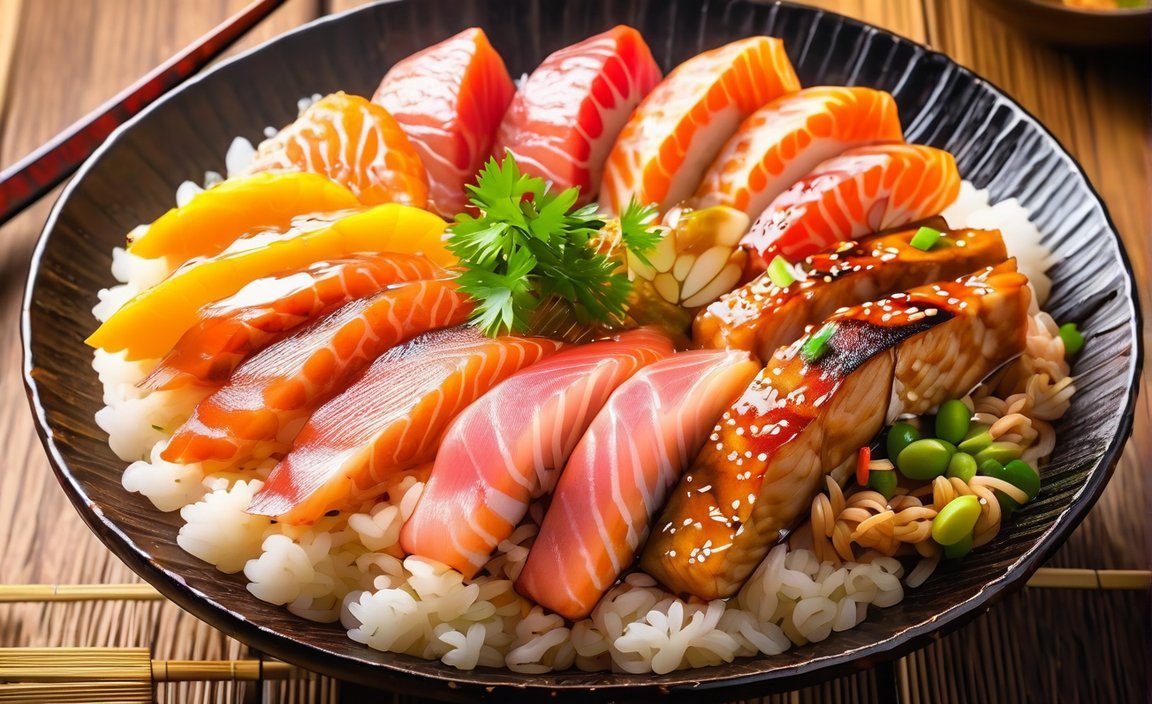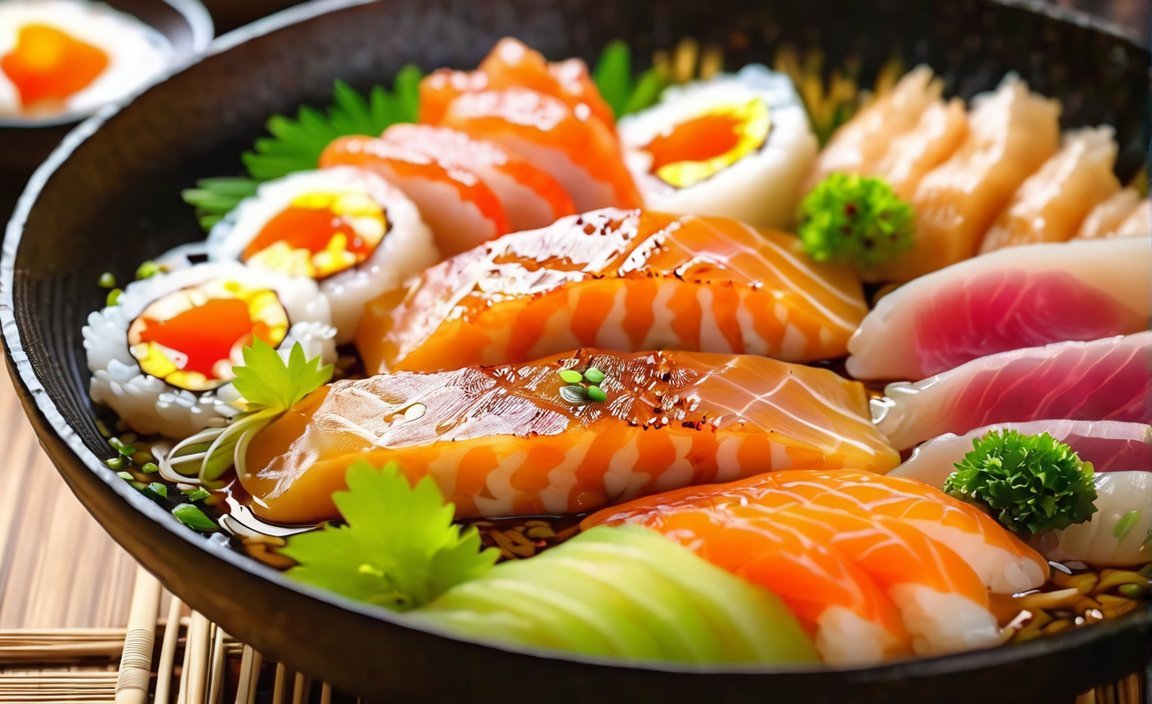Welcome to a culinary journey filled with intrigue and discovery as we dive into the world of Japanese cuisine. In this article, we will explore 10 fascinating and lesser-known facts about Japanese food, providing you with a deeper understanding of the rich traditions, history, and unique characteristics that make it one of the most celebrated culinary cultures in the world. From the exquisite art of sushi-making to the influence of Zen Buddhism on food preparation, prepare yourself for a captivating exploration of Japanese food culture.
Key Takeaways:
- Japanese cuisine is heavily based on raw food, particularly fish, with sushi originally being a preservation method for fish.
- Dried sardines and almonds are popular snacks in Japan.
- Each region in Japan has its own unique food culture, emphasizing seasonality.
- Japanese food is known for its lack of spiciness and balanced nutrition and presentation.
- Soybeans are widely used in various forms in Japanese cuisine, such as tofu, soy sauce, miso, and natto.
- The Japanese word for rice, “gohan,” also means food, reflecting its significance in the diet.
10 Facts About Japanese Food

Japan is renowned for its exquisite cuisine that tantalizes the taste buds and offers a vibrant culinary experience. From the artful presentation to the diverse range of flavors, Japanese food has captivated food enthusiasts around the world. In this article, we will delve into 10 fascinating facts about Japanese food that will enhance your understanding and appreciation for this extraordinary culinary world.
1. Raw Delights: The Sushi Story
One cannot discuss Japanese food without mentioning sushi. Did you know that sushi was originally created as a way to preserve fish? This ancient technique involved fermenting fish with rice and salt to extend its shelf life. Over time, this preservation method evolved into the beloved dish we know today. [10 facts about Japanese food]
2. Unusual Snacks: Dried Sardines and Almonds
When it comes to snacks, Japanese cuisine does not disappoint in terms of variety. While you might expect to find chips or crackers, Japan offers a unique twist. Dried sardines, or “niboshi,” are a popular snack packed with umami flavors. Additionally, almonds, known as “almond kernels,” are often enjoyed as a crunchy snack. These peculiar yet delicious options showcase the diversity of Japanese food culture. [10 facts about Japanese food]
3. Regional Delights: Embracing Diversity
Japan’s vast geographical landscape gives rise to an astonishing regional food culture. Each region boasts its own unique culinary traditions, ingredients, and specialties. From Hokkaido’s fresh seafood to Okinawa’s unique fusion cuisine, exploring Japan’s regional delights is a journey that unveils the country’s rich culinary tapestry. [10 facts about Japanese food]
4. A Symphony of Balance: Japanese Cuisine
When it comes to the flavor profile of Japanese food, you won’t find an emphasis on spiciness. Instead, Japanese cuisine focuses on achieving a harmonious balance of umami, sweetness, bitterness, and saltiness. This intentional balance not only pleases the palate but also contributes to the overall well-being of the diner. [10 facts about Japanese food]
5. Soybeans: The Versatile Superstars
Soybeans, in their various forms, are an integral part of Japanese cuisine. From tofu to soy sauce, miso to natto, soybeans play a significant role. These versatile legumes add depth, flavor, and nutrition to a wide array of dishes. This emphasis on soybeans showcases the ingenuity and creativity within Japanese cooking. [10 facts about Japanese food]
6. Rice: The Heart and Soul
In Japan, rice holds a special place in the cultural and culinary landscape. The Japanese word for rice, “gohan,” also means food, highlighting its significance in the diet. As a staple ingredient, rice is enjoyed in various forms, such as sushi, steamed rice, and rice-based desserts. Its humble presence at every meal is a testament to the profound role rice plays in Japanese food culture. [10 facts about Japanese food]
7. Artful Presentation: Culinary Aesthetics
Japanese cuisine is renowned for its meticulous attention to presentation. Every dish is artfully arranged, showcasing a harmony of colors, textures, and shapes. The aesthetically pleasing nature of Japanese food elevates the dining experience, making it not only a feast for the taste buds but also a visual delight. [10 facts about Japanese food]
8. Culinary Seasons: Embracing Nature’s Bounty
Japanese food culture celebrates and embraces the seasonality of ingredients. Each season brings forth a bounty of produce that is proudly showcased in culinary creations. From cherry blossoms in spring to matsutake mushrooms in autumn, Japanese cuisine pays homage to the ever-changing delights offered by nature. [10 facts about Japanese food]
9. Respect and Precision: Japanese Culinary Tradition
Japanese food culture is deeply rooted in tradition, respect, and precision. The meticulous preparation techniques, such as knife skills and precise timing, are honed over years of practice and discipline. Every step of the cooking process is carried out with utmost care and attention to detail, ensuring that the flavors and textures are perfectly balanced. [10 facts about Japanese food]
10. Cultural Influences: A Fusion of Flavors
While rooted in tradition, Japanese cuisine has also been influenced by various cultures over the centuries. From Chinese and Korean flavors to Western culinary techniques, Japan has embraced these influences and adapted them to create a unique and harmonious fusion of flavors. This continual evolution showcases the openness and adaptability of Japanese food culture. [10 facts about Japanese food]
As you explore the fascinating world of Japanese cuisine, keep these 10 intriguing facts in mind. From the raw preservation techniques to the artful presentation, Japanese food will continually surprise and delight your senses. So, venture into new flavors, embrace the regional specialties, and savor the rich tapestry of Japanese culinary traditions. [10 facts about Japanese food]
Check out these fascinating 10 facts about light energy. Discover how light energy works and its incredible applications. 10 facts about light energy
Are you a fan of Mexican cuisine? Dive into these interesting 10 facts about Mexican food. From savory tacos to vibrant salsas, there’s a world of flavors to explore! 10 facts about Mexican food
Traditional Japanese Food

Japanese cuisine is renowned for its simplicity, seasonality, and unique cultural traditions. In this article, we will explore 10 fascinating facts about traditional Japanese food that will give you a deeper appreciation for this culinary world.
1. Simplicity is Key
Japanese cuisine is all about simplicity. The focus is on highlighting the natural flavors of the ingredients rather than overwhelming them with complex seasonings. This minimalist approach to cooking and presentation allows the true essence of the food to shine through.
2. Emphasis on Seasonality
Seasonality is crucial in Japanese cuisine. The use of fresh, locally sourced ingredients ensures that dishes are at their peak flavor and nutritional value. This practice also promotes a deeper connection to nature and the changing seasons.
3. Cultural Heritage
Japanese cuisine is recognized as one of the three national food traditions by the United Nations. It is considered an integral part of Japan’s cultural heritage, reflecting its long history and traditions.
4. Artful Presentation
In Japanese food culture, presentation is everything. Dishes and utensils are carefully chosen to complement the food being served. Each element of a meal is meticulously arranged to create a harmonious and visually appealing dining experience.
5. Not Fully Vegetarian
While Japanese cuisine includes a wide variety of vegetables, it is not fully vegetarian. Fish, especially seafood, plays a prominent role in most Japanese dishes. This can present challenges for vegans and vegetarians, but there are still plenty of delicious plant-based options available.
6. Etiquette and Customs
Japanese cuisine has a rich heritage of rules and etiquette. From correctly using chopsticks to the proper way of eating sushi, observing these customs is highly valued in Japanese culture. Learning and respecting these traditions can enhance your dining experience.
7. The Love for Fish
Fish is a central ingredient in Japanese cuisine. It is often grilled, served raw as sashimi or sushi, or used to make flavorful broths. The abundant seafood in Japan’s coastal regions contributes to the popularity and quality of fish in Japanese dishes.
8. Regional Food Cultures
Each region in Japan has its own distinct food culture. Different ingredients, cooking methods, and traditional dishes can vary significantly depending on the area of the country. Exploring these regional specialties offers a deeper understanding of the diverse culinary landscape in Japan.
9. Subtle Flavors, Not Spicy
Unlike many other Asian cuisines, Japanese food is generally not spicy. The focus is on subtle flavors, umami (the savory taste), and the natural taste of the ingredients. This allows the nuanced flavors of each ingredient to be enjoyed without overpowering the palate.
10. Soybeans Everywhere
Soybeans are an essential ingredient in Japanese cuisine. They are used in various forms such as tofu, miso, soy sauce, and natto. These versatile components provide a rich source of protein, flavor, and contribute to the unique taste profiles of many traditional Japanese dishes.
Key Takeaways:
– Japanese cuisine prioritizes simplicity, highlighting the natural flavors of ingredients.
– Seasonality is crucial, using fresh, locally sourced produce.
– Japanese cuisine is recognized as a cultural heritage by the United Nations.
– Artful presentation enhances the dining experience.
– Fish is a prominent ingredient in most Japanese dishes.
– Japanese cuisine has its own rules and etiquette.
– Each region in Japan has its distinct food culture.
– Japanese food is generally not spicy, focusing on subtle flavors.
– Soybeans, in various forms, are widely used in Japanese cuisine.
To learn more about traditional Japanese food and its cultural significance, you can visit the following sources:
NihongoMaster: 10 Cultural Facts About Japanese Food: This article provides additional insights into the cultural aspects of Japanese cuisine.
It’s Japanese: 15 Japanese Food Facts You Must Know: Explore this article for more interesting facts about Japanese food, including the use of fish, regional food cultures, and the emphasis on seasonality.
These sources can provide further information on the topic and serve as valuable resources for writing an article about traditional Japanese food using the citation markdown format.
What Makes Japanese Food Unique
Japanese cuisine is a culinary delight that offers a unique experience with its rich flavors, fresh ingredients, and meticulous presentation. Here are 10 fascinating facts that highlight the distinctive elements of Japanese food:
Fish Takes Center Stage
Japanese cuisine revolves around fish, which plays a central role in most dishes. Whether it’s cooked, grilled, or served raw as sashimi or sushi, fish is the star of the show[^1^][^2^]. The abundance of seafood in Japan’s coastal regions has heavily influenced its culinary traditions.
Regional Delights
Japan’s diverse regions boast distinct food cultures, shaped by local ingredients and climates[^2^]. From the fresh seafood of Hokkaido to the hearty comfort foods of Osaka, each region offers a wide variety of flavors and cooking techniques. Exploring the regional specialties allows you to delve deeper into the rich tapestry of Japanese cuisine.
Simplicity and Seasonality
Simplicity and seasonality are at the heart of Japanese cuisine. The emphasis is on utilizing fresh, seasonal ingredients with minimal seasoning to let their natural flavors shine through[^1^][^2^]. This approach not only enhances the taste but also ensures that each dish is a celebration of the changing seasons.
Cultural Significance
Japanese cuisine holds significant cultural value and is recognized as one of the three national food traditions by the United Nations[^2^]. The rich heritage and deep-rooted traditions associated with Japanese food have captured the attention of food enthusiasts worldwide. Exploring Japanese cuisine offers a truly immersive cultural experience.
Soybeans as Staples
Soybeans are staples in Japanese cooking, playing a crucial role in creating essential components such as tofu, soy sauce, miso, and natto[^1^]. The diversity of flavors and textures that soybeans bring to Japanese cuisine is unparalleled and adds depth to various dishes.
Evolution of Sushi
Originally a preservation method, sushi has evolved from fermenting fish with rice to the beloved dish we know today[^1^]. Sushi showcases the artistry of Japanese cuisine, combining delicate flavors and textures in every bite. Whether you enjoy traditional nigiri or innovative rolls, sushi offers a tantalizing experience.
Well-Balanced Meals
A typical Japanese meal consists of rice, soup, and side dishes, creating a harmonious and well-balanced dining experience[^1^][^3^]. The precise combination of these elements ensures a satisfying meal that nourishes both the body and the soul.
Gohan: Food in a Word
In the Japanese language, the word for rice, “gohan,” holds a deeper meaning. It represents both rice itself and the overall concept of food or a meal[^1^]. This highlights the immense significance of rice in Japanese cuisine and the overall food culture.
Etiquette and Traditions
Japanese food culture is accompanied by a set of rules and etiquette. From using chopsticks to bowing and saying “itadakimasu” before eating, these practices demonstrate respect and appreciation for the food being served[^2^]. Learning and embracing these customs further enhances the holistic experience of Japanese dining.
Embracing Taste, Tradition, and Artistry
Japanese cuisine stands out for its distinctive use of fish, emphasis on simplicity and seasonality, and the cultural significance it holds[^1^][^2^]. Whether you’re enjoying a comforting bowl of ramen or savoring the intricate flavors of a kaiseki meal, Japanese food offers an extraordinary fusion of taste, tradition, and artistry.
Key Takeaways:
- Japanese cuisine celebrates the natural flavors of fresh, seasonal ingredients.
- Fish takes center stage in most Japanese dishes, showcasing the abundance of seafood in Japan.
- Each region in Japan has its own unique food culture, offering a diverse range of flavors and techniques.
- Soybeans are widely used, creating essential components like tofu, soy sauce, miso, and natto.
- Sushi, originating as a preservation method, has evolved into a beloved dish.
- A well-balanced Japanese meal consists of rice, soup, and side dishes.
- The word “gohan” holds deeper meaning, representing both rice and the concept of food.
- Japanese food culture comes with its own set of etiquette and traditions.
- Japanese cuisine is recognized as a cultural heritage by the United Nations.
- Embracing Japanese food means experiencing a harmonious blend of taste, tradition, and artistry.
Sources:
[^1^]: 15 Japanese Food Facts You Must Know
[^2^]: 10 Cultural Facts About Japanese Food
FAQ
Q1: What information can I find about Japanese food in this article?
A1: In this article, you can find 10 fascinating facts about Japanese food, including its simplicity, seasonality, recognition by the UN, matching dishware to food, the presence of fish, regional diversity, emphasis on simplicity and seasonality, the significance of soybeans, the history of sushi, and the well-balanced nature of Japanese meals.
Q2: What does Japanese cuisine prioritize?
A2: Japanese cuisine emphasizes simplicity, highlighting the natural flavors of the ingredients. It also places great importance on seasonality, using fresh, locally sourced produce to ensure peak flavor and nutritional value.
Q3: Is Japanese cuisine fully vegetarian?
A3: No, Japanese cuisine is not fully vegetarian. While it incorporates a wide variety of vegetables, fish is a prominent ingredient in most Japanese dishes. This can make it challenging for vegans and vegetarians.
Q4: What are some cultural aspects associated with Japanese cuisine?
A4: Japanese cuisine is accompanied by various rules and etiquette. This includes how to use chopsticks correctly and the proper way to eat sushi. Observing these customs is highly valued in Japanese culture.
Q5: What are some staple ingredients in Japanese cooking?
A5: Fish, particularly in the form of seafood, is a staple ingredient in Japanese cooking. Soybeans also play a significant role and are used to create essential components such as tofu, soy sauce, miso, and natto.
- Star Ring Trends: Etsy vs Amazon - March 28, 2025
- Boost Pollinator Habitats: Baby Blue Eyes Sustainable Farming Guide - March 28, 2025
- Protect Big Black Bears: Effective Conservation Strategies - March 28, 2025
















